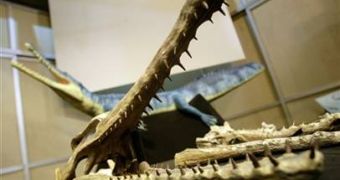Crocodiles are the closest living relatives of dinosaurs (if we exclude birds). Surprisingly or not, they evolved from land animals, fact revealed for example by their longer hind limbs. The first crocodiles during the Triassic (early Mesozoic) even ran on two feet!
Now, a Brazilian team has described in a study published in the "Proceedings of The Royal Society B" a pointy-muzzled crocodile that could have dominated the seas together with the sharks some 62 million years ago, soon after the dinosaur extinction.
The new species, Guarinisuchus munizi, was described based on one of the most complete skeletons of fossil crocodiles so far discovered and could be at least 10 ft (3 m) long.
"The fossil includes a skull, jaw bone and vertebrae, making it one of the most complete examples of marine crocodylomorphs collected so far in South America," said co-author Alexander Kellner of the National Museum of the Federal University of Rio de Janeiro.
"Guarinisuchus appears to be closely related to marine crocodylmorphs found in Africa, which supports the hypothesis that the group originated in Africa and migrated to South America before spreading into the waters off the North American coast," said Kellner.
Sea crocodiles appeared to have replaced the huge predatory marine lizards, called mososaurs, 65 Ma ago, which went extinct at the same time with the dinosaurs. Skull anatomical traits show this was a new species.
The fossils were discovered in the state of Pernambuco (northeastern Brazil) and the species was named after the local tribes of Tupi-Guarani Indians and "munizi" in honor of Brazilian paleontologist Deraldo da Costa Barros Muniz, the discoverer of many dinosaur fossils in the area ("suchus" means crocodile in Old Greek).
Many ancient crocodiles have been found in the last years in Brazil.
In January 2008, a Brazilian team described Montealtosuchus arrudacamposi, a 80 million-year-old 5.5 ft (1.7 m) long terrestrial crocodile (it lived with the dinosaurs) that could be a link between prehistoric and modern-day crocodiles.
In 2006, the same Brazilian team had found the remains of another fossil crocodile, named Uberabasuchus terrificus (terrible crocodile of Uberaba). This species lived 70 million years ago (at the end of the dinosaur times) and was about 10 ft (3 m) long, with a weight around 650 pounds (300 kg).

 14 DAY TRIAL //
14 DAY TRIAL //